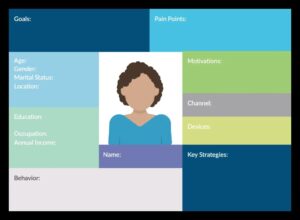You probably need to rethink your personas.
Our job at Jester is simple: observe, disrupt, and tell stories.
We listen and watch, break through to your audience, and use the tools of our trade to unlock your digital potential.
Disrupting your competitive landscape is key to standing out. But sometimes, it isn’t your industry that needs disrupting. To help you tell a better story, sometimes we need to disrupt ours.
The marketing business is full of fads, frameworks and acronyms. Some of these tools offer consistent results and powerful methods for reaching and retaining customers. Others offer great mental shortcuts to help your marketing team organize and strategize.
And sometimes, the marketing industry is better at marketing itself than its clients’ products and services.
So this week we’d like to take an honest look at one of marketing’s go-to devices — the persona.
Why a persona?
Marketing personas help businesses turn scattered market research into coherent and relatable representations of their key customer segments.
We’ve talked before about the value of personas for local marketing and catering to your audience during rapid-fire growth marketing campaigns.
Creating personas can help your company keep its messaging consistent. You’ll have quick access to customer pain points and needs so your departments stay aligned, on brand, and empathetic at each step along the customer journey.
At least, that’s what marketing textbooks and corporate guidelines tell us.
The Problem With Personas
Unfortunately, many marketing personas are vanity assets. 
Busy marketing teams borrow fancy infographic templates designed to impress managers but hide them away thereafter in forgotten folders on dusty hard drives.
The problems with the average persona don’t stop there.
Too many personas create stereotypes out of customers instead of archetypes. They devote more space to what describes someone in a census instead of the deeper traits and needs that drive someone as a person.
They average out customer attributes to maximize reach but sacrifice personalization. And no, a stranger’s headshot doesn’t compensate for the bland mess most of these cookie-cutter personas create for the innovators and empathizers on the team.
Most marketers feel something wrong with these template personas and try to fix the issue with more detail. Their imaginary customer becomes more and more specific until they’ve accidentally narrowed the audience to a segment of one. Or worse, a segment of none. Because there’s no such thing as a truly “average” person.
This isn’t a Goldilocks moment. The solution to the persona problem isn’t to find the “just right” spot between too broad and too narrow.
Save Your Persona
It doesn’t have to be this way.
Personas are all too often built on assumptions, not research. And that’s the real issue here.
Populate your personas with qualitative data instead of empty statistics and trivia.
Our favourite part of any good persona is the quote — one quote that this fictitious customer might actually say.
The first and greatest goal of a marketing persona is to build empathy in your team toward your customers. What better way to stir empathy than actually hearing your customer’s voice?
Do better than one quote.
Start gathering user-generated data from surveys, reviews, comments, client interviews, meetings, and deep-dive research into your current and prospective customers’ public content (whether written or recorded on video or podcasts).
Look for trends in the data and use THOSE to fill out your personas. And if that requires abandoning your stuffy template infographics, even better.
What you’re really looking for in the data is your customer’s mindsets, motivations, and emotional states as they relate to your product or service.
Capture the “why” behind their interactions with your brand, whether they’re searching, buying, enjoying, or seeking support for your product. And as you group “why” answers together, you’ll start to notice the different groups your customers fall into. The next step, creating a persona for each group, will come easy then, because you can borrow from the language and emotions of more than one customer to shape a cohesive persona.
All that humdrum template stuff about demographics, salary, hobbies and fun facts is just the contextual bread in your persona sandwich.
And speaking of sandwiches, you won’t want to miss our next post about the power of stories. There’s a sandwich story involved, and maybe a dining recommendation or two for all our clients in the Ottawa area!
In the meantime, let us know how personas have helped or hindered your marketing campaigns and what steps you’d take to improve them as a marketing tool.

